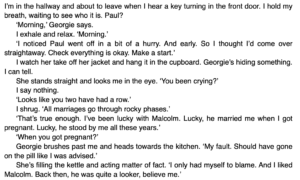Real conversations: Direct versus oblique
In ‘normal conversation’, an exchange can be a sequence of questions and answers to those questions. Here, for example, Jane answers Pauline’s questions.

In fiction, such an exchange has to be short, as it quickly becomes boring.
For longer exchanges, the ‘trick’ is for the characters not to answer the questions. Or to avoid them in some way. To be oblique.
Have your characters go off on a tangent, rather than act in a predictable (boring) way.

Most stories include conflict, so listen to how people argue. In real life, when people argue, they often say something, without taking into account what has just been said to them. There can be a barrage of insults and, only when the heat has gone, and they are actually listening, do they make any progress.
With written material, the reader is ‘listening’ to everything that is being said. If a response demonstrates the person who spoke was not listening, that’s fine; it simply shows there’s an argument in progress.


